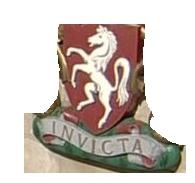
The Jutes Arrive in Britain
During the fifth century, the Britons invited an army of Jutes over to Britain to help defend against the Picts and the Scots.
These Jutish warriors were led by the brothers Hengist and Horsa.
These Jutish warriors were led by the brothers Hengist and Horsa.
Within time, the Jutes brought their families over from Jutland, and they settled in Kent among the native Britons.
With them came the White Horse of Kent, known as the Invicta. This horse is rampant, standing on its hind legs with its front legs in a challenging pose.
With them came the White Horse of Kent, known as the Invicta. This horse is rampant, standing on its hind legs with its front legs in a challenging pose.
The Jutes are said to have also settled in North Rhine-Westphalia, as the emblem of this region of Germany also has a rampant white horse, sibling of the Kentish Invicta.
The name Hengist most likely comes from the German word Hengst, meaning stallion.
And the name Horsa is from the old German word Hors, meaning horse.
As we can see, our Kentish White Horse Invicta is characteristic of the Jutes who settled in Kent.
And the name Horsa is from the old German word Hors, meaning horse.
As we can see, our Kentish White Horse Invicta is characteristic of the Jutes who settled in Kent.
Kent Invicta
The name Invicta is said to have been given to Kent in 1066, after the Battle of Hastings, as William of Normandy, on advancing from Sussex into Kent, came to an agreement with the elders of Kent and promised to honour the Kentish laws, including the law on gavelkind, which assured that land ownership would pass from the parents to all the male heirs equally.
Whatever event led to William the Conqueror acknowledging the motto Invicta for Kent, it was proof that he did not conquer Kent.
No comments:
Post a Comment